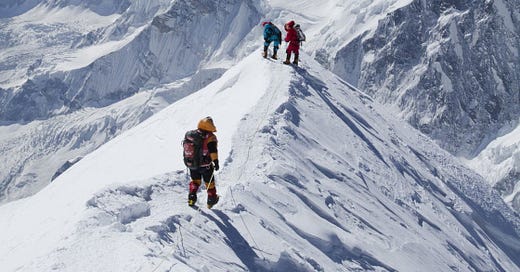Dissent is an uncomfortable journey. For a second, imagine displacing your country’s holidays calendar. If you ever tried changing any long-standing family tradition, you know what I mean. Regardless of the strength of your argument, you’re set for failure.
We rewrite past and future every day. Storytelling is a powerful evolutionary tool, yet it’s deeply embedded in our social fabric. Our story is open, but does not sit in a void.
We're hardwired to seek consensus, like birds in flight, instinctively following invisible social cues. Our stories, intertwined with those of others, influence all of our valuations and actions. The opinions of those closest to us (in spacetime or emotional proximity) form a continuum. The flock stretches, but does not break.
We inherit all of our challenges and opportunities from our environment. They can interfere constructively or destructively with our stories, like waves in a vector field.
We could picture stories roaming on a mountain's surface. A mathematician may call this landscape a vector field. In every point on this surface, there are forces: uphill and downhill paths.
Some theories live uphill. They require a good deal of effort to attain. Contrarian theses, for instance. Unlikely scientific claims need more new evidence to be established (Bayes Theorem).
Summits are rare, but the view from the top is invaluable.
Socially available narratives are downhill. They drag us down like a waterfall. We spend focus and effort to resist our biases. Especially on complex terrains, we need our best cognitive and psychological energies to maintain control of our weight.
On soft and even grounds, downhill slopes can be fun. We can ski to gain rapid enjoyment. We can profit from shared momentum. This is how inner jokes work. They make us feel connected.
What happens when from one summit we peak at the next? What happens when a new physically plausible consensus is at odds with socially dominant narratives?
Sooner or later, disruption ensues. Like a river carving its path, new stories leaves no stone unturned. Any local stationary point eventually gives way to the next in a dynamic equilibrium.
Some of the oldest stories, like calendars, may feel like mountains. But even mountains are not asleep.
Until the next one,
David






loved reading this; when you are at a peak you don't really know you are in one, you can almost never get there analytically and almost certainly have to do that computationally, meaning you have approximations of a peak (or a troughs) but you don't always know precisely where you are on the gradient
also - what are our equations? can we describe the mountain? and how do we describe our direction of travel where nothing is analytical and everything is computational / discrete? love the thinking!